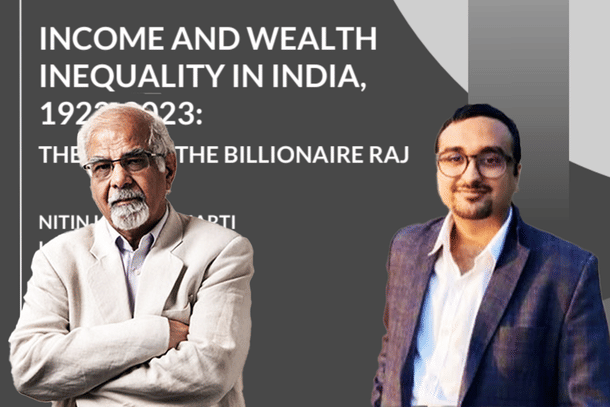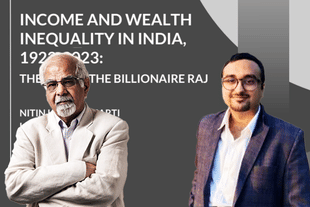Analysis
Report On Inequality In India Under Fire For Relying On Dubious Assumptions
Abhishek Kumar
Mar 27, 2024, 03:28 PM | Updated 03:27 PM IST
Save & read from anywhere!
Bookmark stories for easy access on any device or the Swarajya app.


On 27 March 2024, economists Surjit S Bhalla and Karan Bhasin published their critique of the report on inequality in India. Bhalla and Bhasin went on to show that the report is not able to capture reality on income distribution in the country.
What Does The Report Say?
First let us see the findings of a report titled ‘Income and Wealth Inequality in India, 1922-2023: The Rise of the Billionaire Raj’. It compares income distribution of Indians between 1922 and 2023. Its authors are Thomas Piketty, Nitin Kumar Bharti, Lucas Chancel and Anmol Somanchi.
The report said that in the financial year (FY) 2023, the top 1 per cent of rich people bagged 22.6 per cent of India’s national income. Their share in total wealth has been shown at 40.1 per cent. Remarkably, for 1999, it pegs the same as 21 per cent.
Piketty and team remark that “the ‘Billionaire Raj’ headed by India’s modern bourgeoisie is now more unequal than the British Raj headed by the colonialist forces”. They also hint towards major social and political upheaval due to such inequality.
Failure At The Footnote
Bhalla and Basin looked at the footnote to decode how they arrived at the conclusion. They found out that Piketty and team did not observe income and wealth of the same sets of individuals. Instead, they went on to estimate the full distribution of income and wealth themselves.
Bhalla and Basin question the reliability of such an estimate. In a country like India, even official income distribution surveys can also be different from actual distribution. That is because survey schedules do not cover all households. They further elaborate that billionaires are almost never covered, not only in India, but all across the world.
According to Bhalla and Basin, this discrepancy is one of the key reasons why Piketty and his colleagues came up with their own methods at World Inequality Lab (WIL). They merge tax and non-survey information with survey data in order to increase the accuracy. Even then, it still remains best guess and ‘tentative’, as accepted by Piketty and Co in their paper.
Bhalla and Basin then state that Piketty and the WIL tend to present inequality as a difference between the share of wealth by the top 1 per cent and rest 99 per cent of the population.
Gross Exaggerations Of The Same Data
In 2005, Piketty and Nobel laureate Abhijit Banerjee published the World Bank Economic Review. It analysed India’s income distribution between 1922 and 2000.
The 2005 paper showed that the share of top 1 per cent in the Indian income was 9 per cent, a figure considered remarkably low. But then in 2018, Piketty and Chancel increased the upper year limit to 2015 and published a new version of inequality estimate.
To the utter surprise of Bhalla and Basin, the 9 per cent share in 2005 study was now stretched to 14.7 per cent in 2018, 63 per cent more. They point out that survey and tax data showing such a large deviation from original study is abnormal. Increase of 1 or 2 percentage points (in this case 9 per cent to 9.1 or 9.2 per cent) is acceptable.
In his two critiques of the 2018 paper, Bhalla had asked Piketty and Chancel for the source of these revisions, but did not get any response from them.
In the latest study, the Piketty-Chancel team were buttressed by two additional authors, Nitin Bharti and Anmol Somanchi. The latest study put the 1999 figure of the share of top 1 per cent in the Indian income at 21 per cent, a whopping 133 per cent hike from the original figure of 9 per cent in the 2005 study. Bhalla and Basin point out that this may be one of a kind upward revision in any latest version of past estimates in the economic history.
Piketty's Questionable Past
Piketty’s estimates have come under scanner in the past as well. In one of the works on inequality in the US, Piketty and WIL had allegedly exaggerated the increase in post-tax income shares of the top 1 per cent between 1960 and 2015.
For 1960, the estimate was 9 per cent, which increased to 15 per cent in 2015. Gerald Auten and David Splinter countered it by using tax data. They found out that the post tax-share of the top 1 per cent during the same period (as in WIL) remained steady at around 8-9 per cent.
The 2022 paper of Geloso, Magnes, Moore and Schlosser had found Piketty being biased towards showing high inequality levels.
The 2014 study by Magnes and Murphy even questions methodologies and alleges discrepancies. The study alleges that Piketty cherry picks sources to construct a personal favourite pattern. Opacity, use of ambiguous data and pervasive errors are other key criticisms of Piketty’s works.
Pointing to US’ study, Bhalla and Basin remark that if Piketty and WIL can commit such massive errors in a data-rich country, there is no guarantee they won’t do it in India, where data gathering is more tedious.
Methodology Doesn't Inspire Confidence
Bhalla and Basin also criticise the methodology adopted by Piketty. Apparently, Piketty and team rely on using unobserved data, whose reliability is highly questionable.
Piketty's method is like building a house of cards. They estimate the distribution of wealth and income based on assumptions, and then use those estimates to make further assumptions about inequality trends. If the initial assumptions are shaky, the whole thing comes crashing down. The results might be dramatic, but they might not be reliable.
“Speculating and estimating a distribution conforming to your priors is not economic analysis, robust or otherwise,” they added
Piketty and WIL have also made some policy recommendations like imposing a super tax on Indian billionaires and multimillionaires. Another recommendation is restructuring tax scheduled to include both income and wealth. According to them, it will finance education, health and other public infrastructure.
Bhalla and Basin point out that any such structural overhaul needs rigorous statistics to back them up. “Major investments are based on real data, not on upgraded and inflated estimates of distributions,” wrote Bhalla and Basin.
In the end, Bhalla and Basin advise intellectuals to question what they termed as ‘assumed distributions’ and ‘motivated conclusions’.
Abhishek is Staff Writer at Swarajya.





